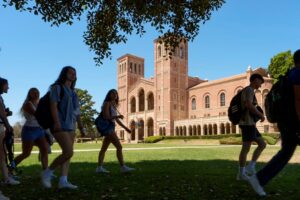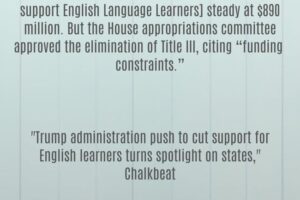
International Enrollment Down at Small, Regional Colleges
Since taking office in January, President Donald Trump and his administration have sought to limit international students in the U.S. The crackdown has included detaining foreign student activists, stripping students’ SEVIS statuses and visas, implementing social media vetting processes, pausing new visa issuances, and seeking to limit students’ length of stay in the country.
Those efforts thus far appeared to have spurred a decline in the number of international students able to enroll and enter the country, according to an Inside Higher Ed analysis of fall enrollment data.
But the federal government has missed its primary target: wealthy, selective colleges and universities, which the administration has accused of denying seats to U.S. students in favor of enrolling higher-paying international students.
“Sometimes what you have, at an elite university, like a Columbia or a Harvard, you have a well-qualified, middle-class American kid from the heartland, who doesn’t get a spot in these universities because some Chinese oligarch who’s paying $100,000 a year takes up that spot,” Vice President JD Vance told Fox News on March 13. “It’s not just bad for national security, it’s bad for the American dream.”
International students, particularly at public institutions, typically pay more than their domestic peers in tuition, and this additional revenue can help offset cost of educating low-income or local students who pay less. A majority of the Ivy League institutions offer need-blind admissions to international students which, in essence, would eliminate bias toward a student who would receive more or less institutional aid.
Advocates for international education have warned these efforts would damage the U.S. at large, reducing revenue to colleges and states, as well as damaging the country’s reputation as a leader in academia. Projections from NAFSA, the association of international educators, estimated that a 15 percent drop in international student enrollment nationwide would result in $7 billion in lost revenue. A more modest estimate of a 10 percent decline would still mean a loss of $3 billion.
But the restrictions on international student enrollment so far haven’t made a dent at Harvard, where administrators anticipate similar numbers of international students for the fall, The Harvard Crimson reported. Harvard is in the middle of a legal battle with the government over its ability to enroll international students, among other issues.
Princeton University, similarly, reported a larger share of international students this fall, with 14 percent of the Class of 2029 hailing from other countries.
Columbia University’s incoming class is 16 percent international students, according to The Columbia Spectator, down from last fall’s 30 percent. International students made up about 20 percent of the total campus population in fall 2024.
Instead, small, regional and private faith-based institutions that enroll a fraction of the country’s foreign scholars have been feeling the greatest declines, according to preliminary data that the colleges shared.
An analysis from the Brookings Institution, published in July, found specialized colleges with smaller enrollments were more likely to have high shares of international students, and a majority of these institutions were Christian colleges.
To NAFSA’s CEO, Fanta Aw, the drop in international students at smaller institutions wasn’t surprising; any enrollment declines hit those with fewer students hardest, she said. Small liberal arts colleges and rural colleges were expected to feel even the slightest change in numbers.
“The turning point was when the government decided that they were going to pause visa interviews,” Aw said. “That impacts every student, irrespective of what institution we go to. The numbers are reflecting the fact that government policies absolutely impacted every type of institution, well beyond the elite.”
Colleges will submit final fall enrollment numbers to the Department of Education in October.
On Campus
Niagara University in upstate New York is a private, Catholic institution that enrolls about 2,700 undergraduates each year. In fall 2024, the university reported 692 international students were part of the Eagle community, comprising about a quarter of its total enrollment. This fall, only 465 international students will be joining the Eagle family, and that’s across the university’s two campuses and graduate programs, a 45 percent drop in enrollment, The Niagara Gazette reported.
Visa delays are keeping students from making it to Niagara, Chandra Foote, the university’s associate provost for graduate and international enrollment, told the Gazette. “We had a lot of students we admitted in March, April and May, and they can’t find an open appointment to have an interview.”
Lee University, a similarly sized Christian school in Tennessee, enrolled 82 international students this past year. Administrators told The Salina Post they’re only expecting 50 or 60 students this fall, a decline as great as 39 percent. The university has already increased tuition 20 percent over the past five years as a way to recoup lost enrollment revenue.
Regional colleges also depend on international student tuition revenue.
Illinois State University enrolled just over 600 international students, a majority of whom are graduate students. ISU anticipates enrollment to drop over all by about 31 percent this fall and only about 100 new international students in total, according to WGLT.
Cleveland State University administrators said in May that they expected 579 fewer international students this fall—486 of whom are returning students—which could result in $11.5 million in lost revenue, as reported by Crain’s Cleveland Business.
Central Michigan University hosted 1,659 international students in fall 2024, typically welcoming between 500 to 600 new students each year, according to a university spokesman. This year, CMU expects 1,210 nondomestic students on campus, a 23 percent drop.
Even flagship institutions are feeling the effects of fewer international students, in large part because of fewer master’s students, Aw said.
Given the uncertainty surrounding international student enrollment, it was expected that postgraduate students who are in shorter-term programs would be less likely to apply and enroll for this calendar year. In addition, a majority of master’s students hail from India and China, which were among the countries that saw higher disruptions to visa interview appointments this summer.
The University of North Texas ranks No. 10 in the country for number of international students enrolled, according to OpenDoors data, hosting 11,900 foreign students in the 2023–24 academic year alone, making up about 23 percent of the university’s total enrollment.
Even before this fall, UNT reported expected to lose about $47.3 million in anticipated net tuition and fees from slowing international student enrollment in 2024–25. “Fall 2025 international student enrollment currently indicates a similar decline,” according to meeting notes.
Indiana University, Indianapolis, reported 26 percent fewer international students this fall, enrolling just over 1,000 learners compared to nearly 1,400 in fall 2024. The flagship campus, IU Bloomington, also reported a year-over-year enrollment decline of 11 percent, according to systemwide data.
The University at Buffalo, part of the State University of New York system, had about 750 fewer international students on campus this far, NPR reported. UB provost A. Scott Weber added in an August message to the campus community that the university saw significant drops in international student enrollment within graduate programs and STEM master’s programs, specifically,
The University of Wisconsin, Madison, is seeing international student applications stall for the first time in over a decade, administrators told The Cap Times. UW Madison hosted 9,500-plus international students in 2023–24, per OpenDoors data; exact numbers for this fall have yet to be shared.
Survey Says
A June poll found a majority of Americans disapprove of the Trump administration’s approach to issues of higher education. Regarding international students, 40 percent of respondents indicated that they disapproved of the Trump administration’s decision to monitor international students’ social media accounts, and 80 percent believe the president should not have the authority to determine which colleges and universities can enroll foreign students.
Nearly three in five respondents support awarding green cards to foreign students who graduate from American universities so they can work in the U.S. after they graduate.
Visa Slowdown
International scholars say they’re interested in studying in the U.S., despite changing policies from the government and shaky campus climates. The most significant and prevalent barrier to arrival is securing a student visa.
Recent data from the U.S. International Trade Association reported 28 percent fewer visitors, or about 30,500 students, arrived in the U.S. on a student visa in July 2025 compared to the year prior. In May, the State Department issued 17,000 fewer F-1 and J-1 visas, compared to the same period a year ago. (The State Department has not published more recent data since May.)
Fewer than half of all incoming international students were able to schedule a visa interview before May, Aw said, which caused a backlog internationally and especially within countries that enroll greater shares of international students, such as China, India and Nigeria.
Some international students who were previously enrolled or living in the U.S. may have chosen to stay in the country for the summer, reducing the need for them to file for a new visa. But the data signals a decrease in new students over all.
Many institutions say they’re working with incoming students to find alternate opportunities for them to remain enrolled. The most common solution is allowing students to defer their enrollment to the spring term, which alleviates pressure to get a student visa immediately.
“The fact that [international students] are willing to defer tells you that the quality really matters in their decision,” Aw said. “They’re cautiously optimistic that perhaps things can change.”
Central Michigan officials said over 600 international students deferred their enrollment to another semester due to visa complications. Minnesota State University, Mankato, created a new midsemester start option, giving international students a few extra weeks to secure a visa but still arrive before January.
Other accommodations including enrolling the student at an international campus—Niagara University is placing some students at Salzburg College in Austria, for example—or allowing students to complete classes online.
Aw anticipates the visa bottleneck to alleviate over the coming months, but she noted that colleges should not anticipate every deferred student to arrive on campus in the spring, as some may choose to study in another nation.
“If they choose to go to the U.K. or elsewhere and deferred with a U.S. institution, we will lose them,” Aw said. “Once they actually go to another country, the odds of them leaving that to come to a third country are very slim.”



